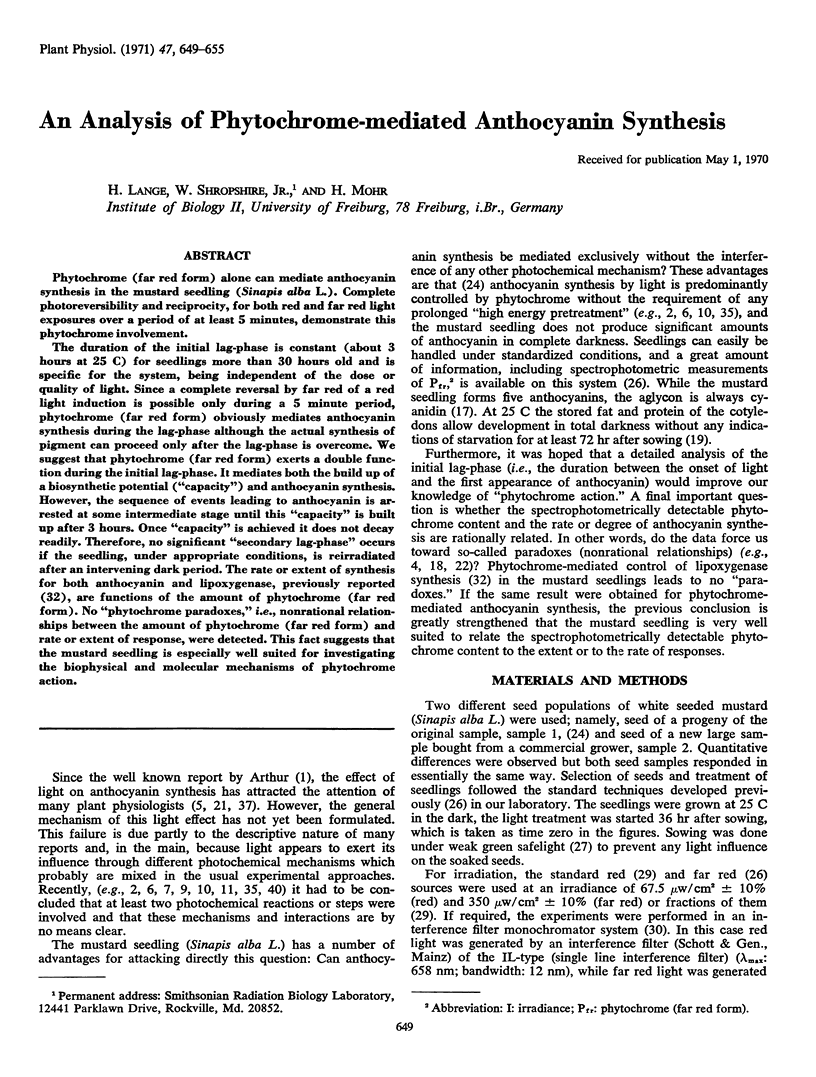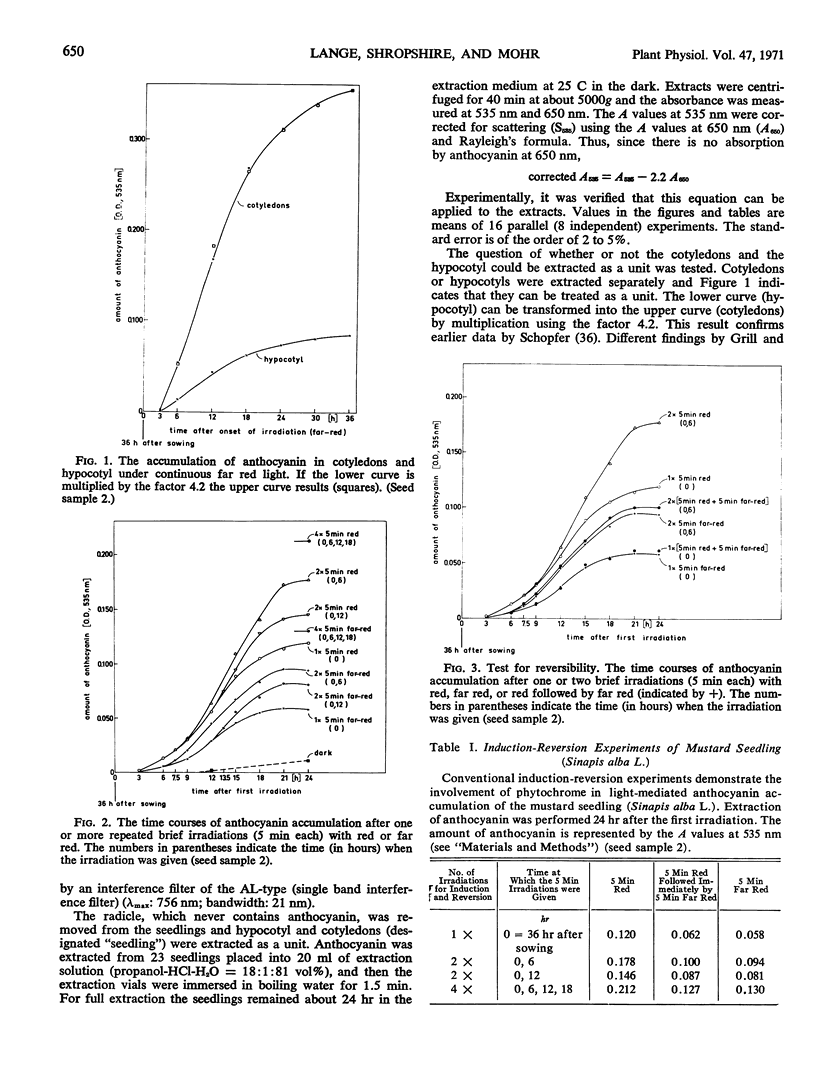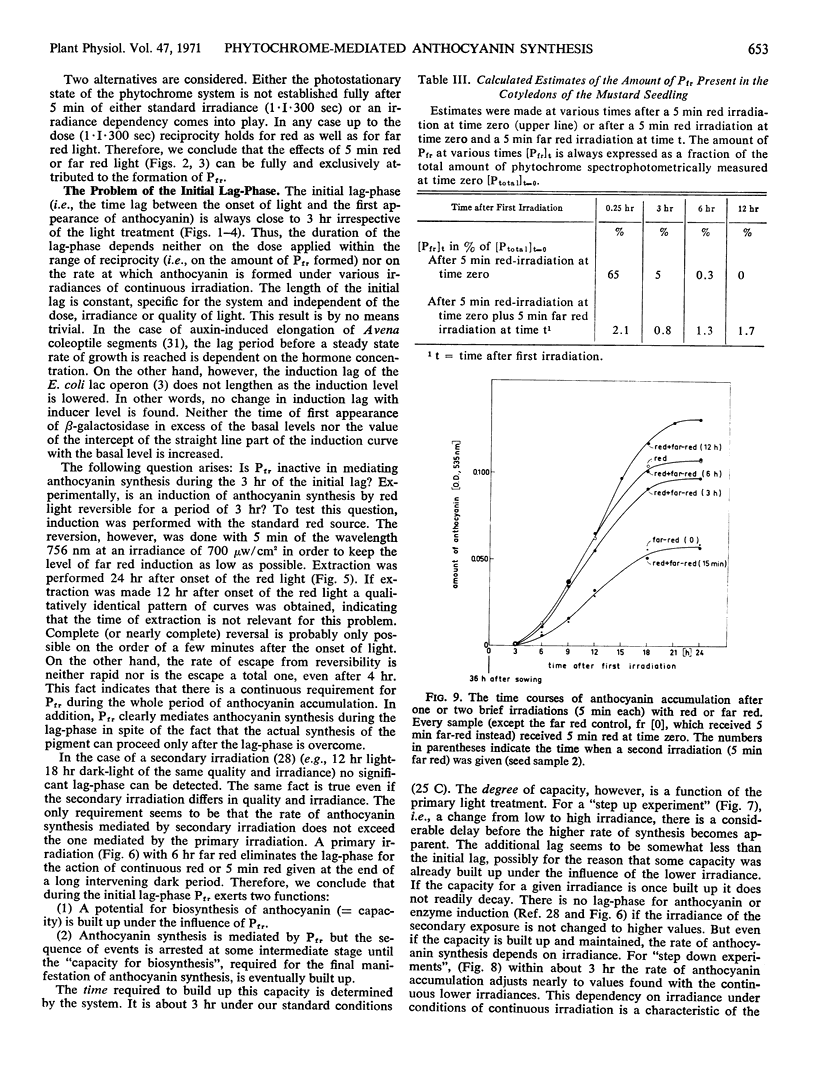Abstract
Phytochrome (far red form) alone can mediate anthocyanin synthesis in the mustard seedling (Sinapis alba L.). Complete photoreversibility and reciprocity, for both red and far red light exposures over a period of at least 5 minutes, demonstrate this phytochrome involvement.
The duration of the initial lag-phase is constant (about 3 hours at 25 C) for seedlings more than 30 hours old and is specific for the system, being independent of the dose or quality of light. Since a complete reversal by far red of a red light induction is possible only during a 5 minute period, phytochrome (far red form) obviously mediates anthocyanin synthesis during the lag-phase although the actual synthesis of pigment can proceed only after the lag-phase is overcome. We suggest that phytochrome (far red form) exerts a double function during the initial lag-phase. It mediates both the build up of a biosynthetic potential (“capacity”) and anthocyanin synthesis. However, the sequence of events leading to anthocyanin is arrested at some intermediate stage until this “capacity” is built up after 3 hours. Once “capacity” is achieved it does not decay readily. Therefore, no significant “secondary lag-phase” occurs if the seedling, under appropriate conditions, is reirradiated after an intervening dark period. The rate or extent of synthesis for both anthocyanin and lipoxygenase, previously reported (32), are functions of the amount of phytochrome (far red form). No “phytochrome paradoxes,” i.e., nonrational relationships between the amount of phytochrome (far red form) and rate or extent of response, were detected. This fact suggests that the mustard seedling is especially well suited for investigating the biophysical and molecular mechanisms of phytochrome action.
Full text
PDF






Selected References
These references are in PubMed. This may not be the complete list of references from this article.
- Branscomb E. W., Stuart R. N. Induction lag as a function of induction level. Biochem Biophys Res Commun. 1968 Aug 21;32(4):731–738. doi: 10.1016/0006-291x(68)90300-8. [DOI] [PubMed] [Google Scholar]
- Downs R. J., Siegelman H. W. Photocontrol of Anthocyanin Synthesis in Milo Seedlings. Plant Physiol. 1963 Jan;38(1):25–30. doi: 10.1104/pp.38.1.25. [DOI] [PMC free article] [PubMed] [Google Scholar]
- Durst F., Mohr H. Phytochrome-mediated induction of enzyme synthesis in mustard seedlings(Sinapis alba L.). Naturwissenschaften. 1966 Oct;53(20):531–532. doi: 10.1007/BF00600655. [DOI] [PubMed] [Google Scholar]
- Hartmann K. M. Ein Wirkungsspektrum der Photomorphogenese unter Hochenergiebedingungen und seine Interpretation auf der Basis des Phytochroms (Hypokotylwachstumshemmung bei Lactuca sativa L.) Z Naturforsch B. 1967 Nov;22(11):1172–1175. [PubMed] [Google Scholar]
- Hopkins W. G., Hillman W. S. Relationships between phytochrome state and photosensitive growth of Avena coleoptile segments. Plant Physiol. 1966 Apr;41(4):593–598. doi: 10.1104/pp.41.4.593. [DOI] [PMC free article] [PubMed] [Google Scholar]
- Klein A. O. Persistent photoreversibility of leaf development. Plant Physiol. 1969 Jun;44(6):897–902. doi: 10.1104/pp.44.6.897. [DOI] [PMC free article] [PubMed] [Google Scholar]
- NG Y. L., THIMANN K. V., GORDON S. A. THE BIOGENESIS OF ANTHOCYANINS. X. THE ACTION SPECTRUM FOR ANTHOCYANIN FORMATION IN SPIRODELA OLIGORRHIZA. Arch Biochem Biophys. 1964 Sep;107:550–558. doi: 10.1016/0003-9861(64)90315-7. [DOI] [PubMed] [Google Scholar]
- Oelze-Karow H., Schopfer P., Mohr H. Phytochrome-mediated repression of enzyme synthesis (lipoxygenase): a threshold phenomenon. Proc Natl Acad Sci U S A. 1970 Jan;65(1):51–57. doi: 10.1073/pnas.65.1.51. [DOI] [PMC free article] [PubMed] [Google Scholar]
- Siegelman H. W., Hendricks S. B. Photocontrol of Anthocyanin Formation in Turnip and Red Cabbage Seedlings. Plant Physiol. 1957 Sep;32(5):393–398. doi: 10.1104/pp.32.5.393. [DOI] [PMC free article] [PubMed] [Google Scholar]


